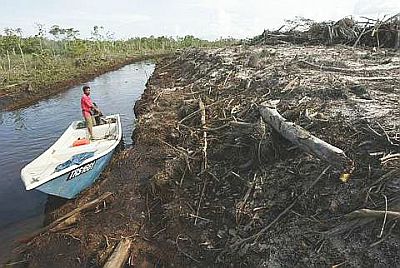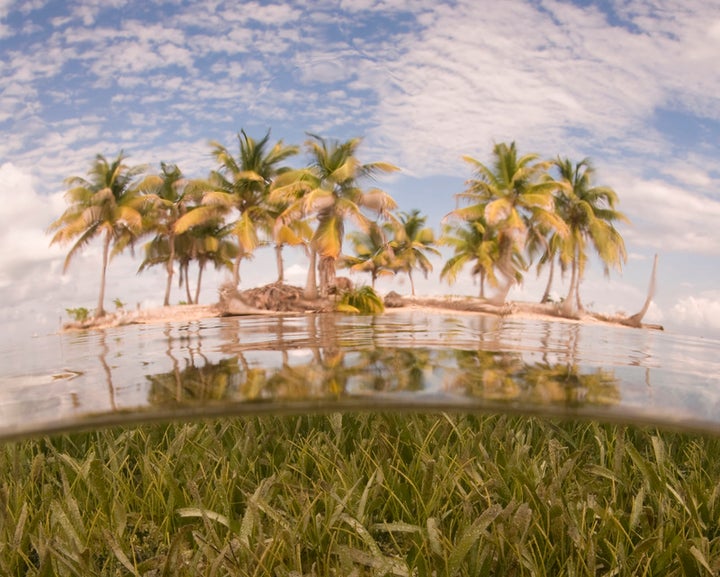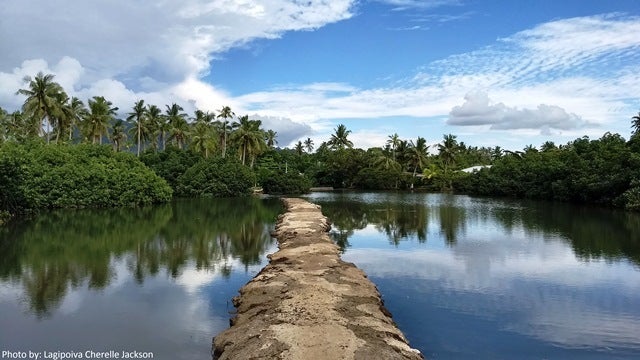|
The MAP News |
|
|
FEATURE STORY
MAP Joins Climate Action call for Climate Partnerships
 GLOBAL - A new effort to mobilize the world to stop mangrove deforestation and to undertake a massive restoration effort is underway. The goal of the Alliance is to expand overall extent of mangrove forests 20 percent by 2030. WWF, Conservation International, The Nature Conservancy, the International Union for the Conservation of Nature, Wetlands International (and now Mangrove Action Project) have joined together to take up this challenge. And that list is growing. The Global Mangrove Alliance was born of the belief that a renewed effort is needed across multiple sectors and geographies to give mangroves their due, and to massively scale and accelerate conservation and restoration of mangrove ecosystems. The know-how exists; it is the will and interest to act that needs bolstering. The Paris agreement and its focus on developing country-by-country plans to reduce carbon emissions is a new moment that will allow us to both accelerate existing work to protect and restore mangroves while generating and funneling significant new global investment. If we can generate enough momentum to accomplish these ambitious aims, we can improve the well-being of tens of millions of people and revitalize critical coastal ecosystems. READ MORE AFRICA Parks and Wildlife plants mangrove along Bintang Bolong GAMBIA - The Department of Parks and Wildlife, in collaboration with Sahel Wetland and communities of Kanlagi Jifarong, Bondali and Brikama Ndinding, recently conducted a two-day mangrove planting in various parts of Bintang Bolong estuary. The Department of Parks and Wildlife technical team supervised the planting. Speaking at the event, Kawsu Jammeh of Parks and Wildlife said while they are planting mangrove to restore biodiversity within it they must also recognised as conservations specialist to provide landing and feeding areas for wading water birds and habitat for mud crabs. According to Mr Jammeh, The Gambia has quiet and good representative birds, reptiles, butterflies, insects, fisheries and mammals that could be attractive to tourists. “There is no more stock you can find anywhere except in and around protected areas,” he said. “We do not have to wait until the forest disappears completely,” he said, adding that they must endeavour to restore the wetland because they need healthy environment to continue to support the necessary goods and produce for the wellbeing of the future generation. VIEW SOURCE Flooding is going to get a lot worse in Nigeria  NIGERIA - Earlier this year heavy rains and thunderstorms caused havoc in Lagos, Nigeria’s economic nerve centre and one of Africa’s most populous cities. Residents woke up in many parts of the city to find their streets and homes flooded and their property, including cars and other valuables, submerged. Some of the worst flooding in recent memory happened five years ago in March 2012 when 32 of Nigeria’s 36 states were affected, 24 severely. More than 360 people were killed and almost two million people were displaced. The seriousness of the flooding was attributed to a combination of two events: very heavy local rainfall and the release of excess water from the Lagdo Dam in nearby Cameroon. What’s complicated the situation for Lagos is that many parts of the city were originally low-lying mangrove swamps and wetlands, which have been reclaimed and settled, mostly by poorer communities and more recently through concerted efforts by the government. READ MORE ASIA Community-based ecological mangrove restoration against coastal hazards  THAILAND - Thailand has experienced a rapid loss of coastal mangroves due to a range of natural and anthropogenic factors. Shrimp aquaculture has been attributed as the largest single cause of mangrove loss in Thailand and South-east Asia. Clearance of mangroves has now left many coastal communities exposed to natural hazards like cyclones, storm surges, and tsunami. Increased salt intrusion is also affecting fresh water supplies. Currently abandoned ponds dominate large coastal areas and without the protective services of mangrove forests, the coastal communities are very vulnerable to natural hazards. EPIC is implementing Community-based Ecological Mangrove Restoration (CBEMR) in two coastal sites in Thailand. CBEMR is a mangrove restoration technique that emerged in response to other type of restoration that have failed for example monoculture plantation of mangroves. It is also an innovative approach to natural resource management and combines scientific research, situational analyses and local knowledge for the integration of ecological restoration, disaster risk reduction, climate change adaptation and livelihood diversification. READ MORE Tree-planting drones can sow 100,000 seeds a day  MYANMAR - The much-hyped promise of a drone-driven future—where drones bring us food, take our selfies, and even serve as taxis—is not nearly as cool as this Myanmar community’s drone-driven present. A group of villagers along the country’s Irrawaddy River will soon use drones to plant a million new mangrove trees in an effort to restore the area’s natural ecosystem. After several years of planting the mangroves manually, the villagers and nonprofit Worldview International Foundation are teaming up with drones and pilots from BioCarbon Engineering to seed an additional 600 acres of land—freeing up their time to tend to saplings and more mature trees. The drones have two jobs in the planting. First, they fly over the land, mapping the terrain and collecting information about its topography and soil. This data is then processed by an algorithm to determine where to plant and what species of tree would thrive. Then, another set of drones is each given a batch of specially designed seed pods and sent out. Flying low over the ground, the planter drones follow instructions determined by the data on where to go and when to fire a seed pod into the ground. They’re accurate to within centimeters. READ MORE Mangroves: A Star Player In The Coastal Protection Game  PHILIPPINES - Mangroves are being lost around the world—often converted to shrimp aquaculture that provides short-term gains for local economies. In just a few years, these ponds become diseased and are abandoned. And the lasting value of those mangroves—including protecting communities from flood—is lost forever. The Nature Conservancy recently partnered with World Bank, the Philippines Government and the University of Cantabria to determine the value of mangroves in the Philippines for risk reduction. With the Bank, we developed guidelines and applied tools developed by the engineering and insurance sectors to determine the value of benefits from mangroves and other critical coastal habitats, like reefs. We also applied state of the art hydrodynamic and economic models to show how critical these habitats are. The findings are significant. READ MORE AMERICAS Forest And Protected Areas Of Trinidad And Tobago With the boast of being home to the oldest Forest Reserve in the Western Hemisphere – the Main Ridge Forest Reserve in Tobago, which was declared in 1764 – Trinidad and Tobago has demonstrated a history of taking strategic steps to protecting its natural heritage. Up to 2015, some seventy-five (75) areas were provided legal protection under various Acts, and some 100 other sites inventoried for designation as heritage sites across both islands. From that year, steps were taken to review these designations and institute a new regulatory framework and management system for protected areas, by piloting an approach in six pilot protected areas. This website was developed during that process, and is the repository of all current information on designated Protected Areas outlined in the National Protected Areas Policy of the Government of the Republic of Trinidad and Tobago (2011). The site will be continually updated to serve as an important resource for dissemination of accurate and up-to-date information on these sites. We hope you enjoy your visit. READ MORE OCEANA Mangroves and their value to Samoa  SOMOA - Mangroves in Samoa have been threatened due to increasing coastal population, development and settlement. In the last five years, the Mangrove Ecosystems for Climate Change Adaptation and Livelihood Project in Samoa published some key findings in their work on one particular site, Le Asaga Bay in Samoa. According to the report Le Asaga Bay has the third biggest mangrove cover and the biggest mangrove estuary of all mangrove stands in Samoa. It also affords the most essential ecosystem goods and services which highly contribute to upholding the environment and sustaining people’s livelihoods. Such a significant area in a fairly healthy condition deserves effective management which includes sustainable utilization of resources. Even that need is urgent with the impacts of climate change that can be attributed to prolonged spring tides submerging and stressing the mangroves, eroding the coast and gradually reducing mangrove cover. According to the Secretariat of the Pacific Regional Environment Programme (SPREP) Samoa hosts the largest intact mangrove forest forest in all of Polynesia. READ MORE GLOBAL Ecosystems Protecting Infrastructure and Communities  GLOBAL - EPIC is a five year initiative that is promoting the implementation of ecosystem-based disaster risk reduction through 5 Case studies in Burkina Faso, Chile, China, Nepal, Senegal and Thailand. The project is contributing to community resilience by: • Documenting scientific evidence • Building capacities to understand vulnerabilities and take action by using best practices • Promoting effective policies for integrated approaches to disasters, climate change and environment management. During the past few decades the number of disasters and their impacts on communities worldwide has increased steadily. With climate change, this trend is set to continue, with an expected increase in the number of extreme weather events. Healthy ecosystems can be important allies in reducing risk and increasing resilience for people and the environment. READ MORE Nominations sought for Wangari Maathai Forest Champion Award 2017 GLOBAL - The Collaborative Partnership on Forests (CPF) is awarding one extraordinary individual for improving our forests and the lives of people who depend on them! The CPF launched the first Wangari Maathai Award in 2012 to honour and commemorate the impact of this extraordinary woman who championed forest issues around the world. In 2017, the CPF will award another individual for her/his outstanding achievements for forests. Applicants should be nominated by a third party. Nominees may be persons, living or recently deceased, who have made exceptional contributions to forests. The awardee will receive a cash prize of USD20,000 along with international recognition of the outstanding contributions to preserve, restore and sustainably manage forests and to raise awareness of the key role forests play in supporting local communities, rural livelihoods, women and the environment. Professional and research contributions will only be considered if they are conducted outside of normal work-related responsibilities. Applications received from a nominee’s kin or business partner are not eligible for consideration. Applications related to grassroots initiatives are particularly encouraged. The closing date for receipt of nominations is 31 August 2017. READ MORE Recently I learnt of a plan to destroy mangroves in New Zealand. A bill is before Government to authorize the legal destruction of NZ's mangrove resources. The plan is dressed up as "management".The theme of this is not management.It is eradication. The driving forces behind this plan seem to be marinas and boats. The eco-economics of mangrove resources such as their outstandingly important role in protecting valuable dairy farm land from inundation: in the Hauraki region of NZ,we have mangrove stands which protect the stop banks which,themselves, seek to protect low lying farmlands. In addition, these mangroves sustain coastal fisheries. I have been doing the science associated with the wisdom of our mangroves,unispecific ecosystems of Avicennia marina, since 1969 and are shocked at the whole idea.I have a paper on the economic importance of NZ mangroves ( 1976) published by the (then) National Environment Council in which the eco-engineering values of these Hauraki mangroves was strongly stated and respected by local environmental engineers. A move to remove mangrove vegetation along the lines advocated by this bill before Government would place New Zealand, a developed country, in start contrast to the so-called developing nations like Thailand who place a high value on these eco-economic multi-functional assets. I feel that it is my duty to share this unwanted News Flash with MAP ! Prof Gordon S.Maxwell, FRSB,FLS and Life member, ISME. Prof Gordon S. Maxwell FSB, FLS gmaxnz@ihug.co.nz |
ACTION ALERTS
Want to learn more about mangroves? |
Mangrove Action ProjectClick here to view past newsletters |
|
Search News Archive
Thursday, August 17, 2017
MAP News Issue 423, August 19, 2017
Subscribe to:
Post Comments (Atom)
-
The community of adults and youth in Cayman Islands has come together recently to release a series of educational videos. Each is geared to...
-
By Alfredo Quarto, Program & Policy Director Co-founder, MAP There is a rather urgent situation concerning the bio-invasion of the Son...
-
By: Isabel Robinson, MAP Volunteer Intern Some months ago I decided to come to Thailand and do an internship in mangrove conservation, ...
MAP News Issue #595 - April 6, 2024
Push to restore Philippines' mangroves at risk from salt farm law PHILIPPINES - Along the flood-prone coasts of the Philippines, one o...










No comments:
Post a Comment
Note: Only a member of this blog may post a comment.